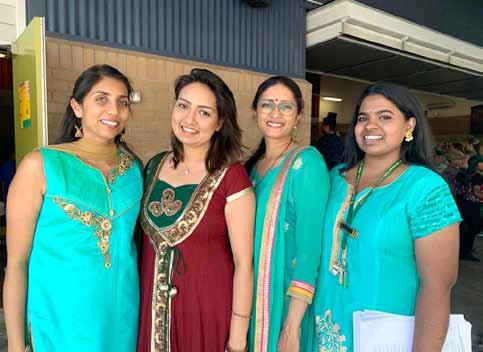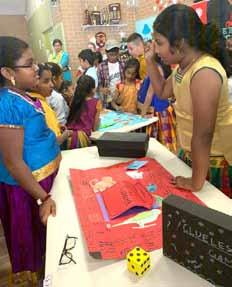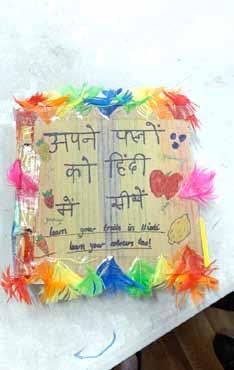
3 minute read
Break n the language arr er
from 2019-12 Sydney
by Indian Link
Pr ary st dents at G rraween P l S hool sh ne at na ral o n ty lan a e show ase on ert
confidently. t actually or s ecause at the end of ear the ids ant to continue their language lessons.
BY JANANI K ARTHIK
Girra een u lic chool turned a lot more colourful than usual recently as Tamil/Hindi language students turned up in traditional attire for their annual sho case concert.
Some 700 primary school students learn an Indian language at the school, 300 in Tamil classes and 400 in Hindi classes, in ears to .

t the recent sho case students performed to popular Tamil and Hindi songs, and presented beautiful recitations of Tamil and Hindi versions of English rhymes such as Wheels On The Bus, Head Shoulders Knees and Toes, and Baby Shark.
“This is the second year of this celebratory event,” Premala Nadesan, a Tamil teacher at the school, told Indian Link. “The kids are e cited not only to ear their traditional garments, but also to see their friends and teachers in theirs! It is a great feeling for the children to see the hole school in ol ed in their culture e en if for a day.
Even Principal Glenn Walker participated, joining the language teachers in a dance performance to the current Hindi hit Aankh Maare. t as a resentation that ent do n ell ith students as ell as arents in attendance.
About the significance of learning languages indi teacher anu Tandon said anguage classes hel to reach out to the third generation children. f e don t create the a areness for them a out their language no they may e entually lose it altogether. In our culture-integrated language classes, kids share their experiences from home more than they ould out in the layground and so it all adds u .
Anjali Dhond, another Hindi teacher, added, “These classes also help in relating better to their extended families back in ndia es ecially grand arents.

ids attend community language classes for an hour e ery ee during school hours in hich they erform a ariety of language tas s. n ali said The ids or on s ecific reading listening riting and s ea ing tas s designed by us and get to analyse and explore the language. e assess their a ility through final tas s in hich they erform acti ities such as a role lay and resent a iece.
Tamil teacher Heerthayini
Janapalachandran chimed in, “Our teaching techni ues are uite different to ho e learned languages oursel es as ids. The Tamil indi sylla us that e teach here is modified to cater to the children brought up in ustralia. er and a o e en and a er e ma e our lessons fun and engaging e are responsible to instil interest in the kids first and then gradually get them conversing n re arations for the sho case the students actively engaged in project-based learning or ing in grou s to de elo u les and games. alyani another arent said e are Telugu speakers but have enrolled our child in the Tamil class. e figured it ould e good to learn at least one ndian language. We are thrilled to hear the Principal’s announcement regarding Telugu!”

Archana, a Year 4 student, said, “I think it is im ortant to read and rite my o n language. m en oying my language classes. or ed on a ro ect a out different Tamil festi als. y fa ourite Tamil festi al is Tamil e ear.
Another student Chitrita said, “I'm originally from angladesh. learn indi here. am thrilled to learn a ne language. For her project, Chitrita created a book of flo ers ith their names in indi. Anokshikhaa learned the names of animals in Tamil for her ro ect.

Talking at the event, Principal Glenn Walker said, “By learning an additional language students ill de elo s ills in areas of communication, intercultural understanding, social cohesion, language and intercultural a areness. ommunity language classes are an important link to our community. e t year e ill e and the language classes y including Telugu.
Heerthayini agreed that language learning results in enhanced cogniti e s ills. ot only is there better speech and hearing, she shared ut also greater focus e cient memory a ility to uggle et een tas s manage conflicts, and better information rocessing o erall.
For migrant kids, such programs also help in identity formation, foster self-esteem, and ee at ay feelings of social isolation. ur son did not no a ord of Tamil before joining this school,” admitted Hema, a arent ho attended the sho case. o he is increasingly using Tamil at home. e lo e it that he is able to learn his mother tongue at school.









